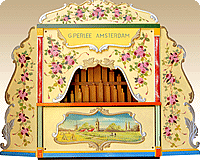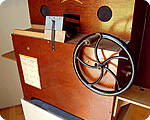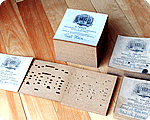Introducing some of Akio Morita's particular favorites from among the 'sound toys' that he collected all over the world.


This happened in the summer of 1953, when Akio returned from his first trip to Europe. It seems that during this trip he had become very interested in a street organ that he happened to see in a street in Holland, and had decided that somehow he would get hold of one. I wasn't sure whether his intention was serious or whether he had gone a little crazy. As you may know, these "street organs" are hand-pumped pipe-organs mounted on large carts. In Holland, they appear on the streets as though from nowhere early in the morning and in the evening to play their music.

You insert a set of punch cards that are joined together at the edges, and turn a wheel attached to the side of the instrument. The sound that emerges varies depending on the positions of the holes in the paper through which the air passes.
The music produced is actually a work of art. The organ-grinder's musical sense is reflected in the melody by the way he turns the wheel. Akio intended to drag an actual street organ into a room in our house that measured no more than 15m2. If he had, somebody would have had to sleep under the cart.

For the next ten years, he did his best to acquire a street organ. Every time he went to Europe he would try, and he would corner his friends from Europe and ask them to try, too. But the answer was always "No." You can't export these organs. I believe that it's forbidden under Dutch law. The reason is that they rank along with the windmills and the tulips that bloom in late spring as cultural treasures that evoke the Holland of old. They are also a valuable asset to the tourism industry.
Whether or not this is the reason, I was also told that these organs are only tuned by representatives of the Dutch government, so it made sense that their export should not be permitted. Akio's dream was dashed. But after ten years, someone brought wonderful news. There was a single Dutch craftsman who made miniature street organs.
That's how one of these miniature organs became a member of our household. It has provided an enjoyable and tireless topic of conversation with visitors from all over the world, especially Europe.
Yoshiko Morita, May 14, 2007



























 The Street Organ
The Street Organ



